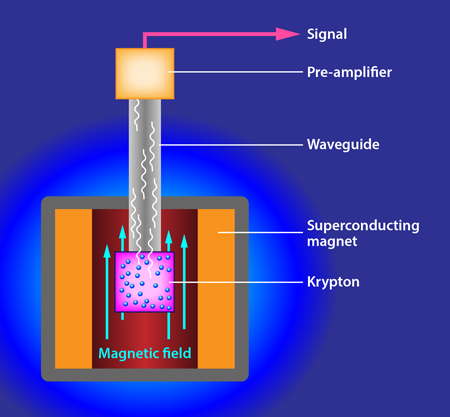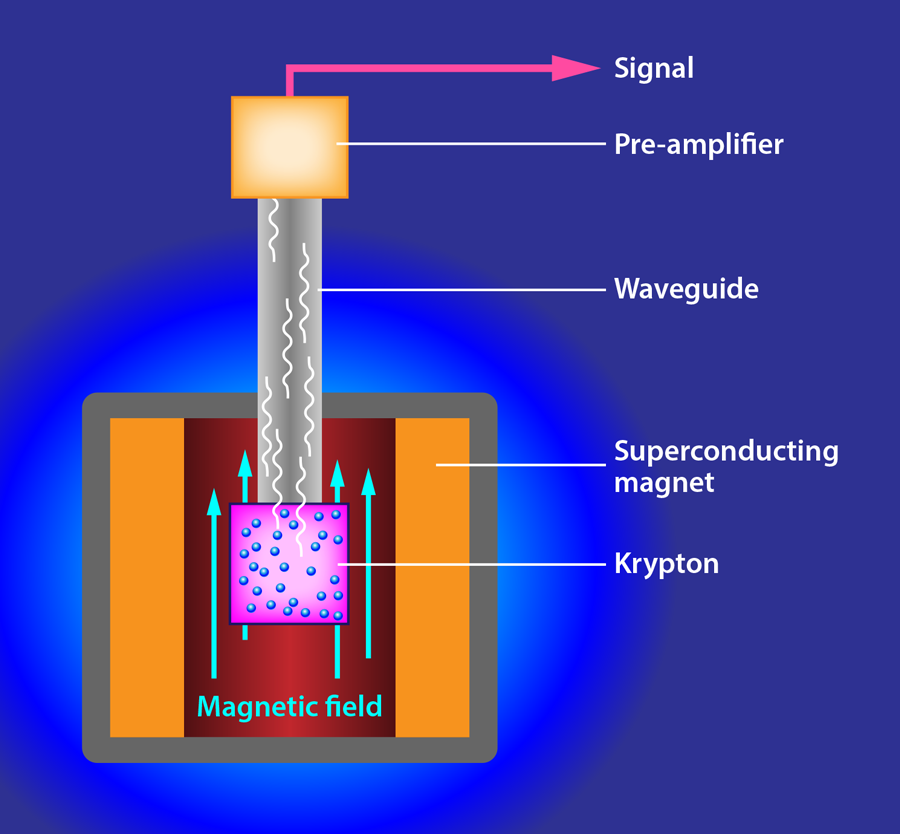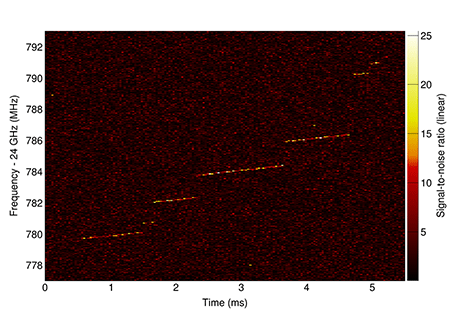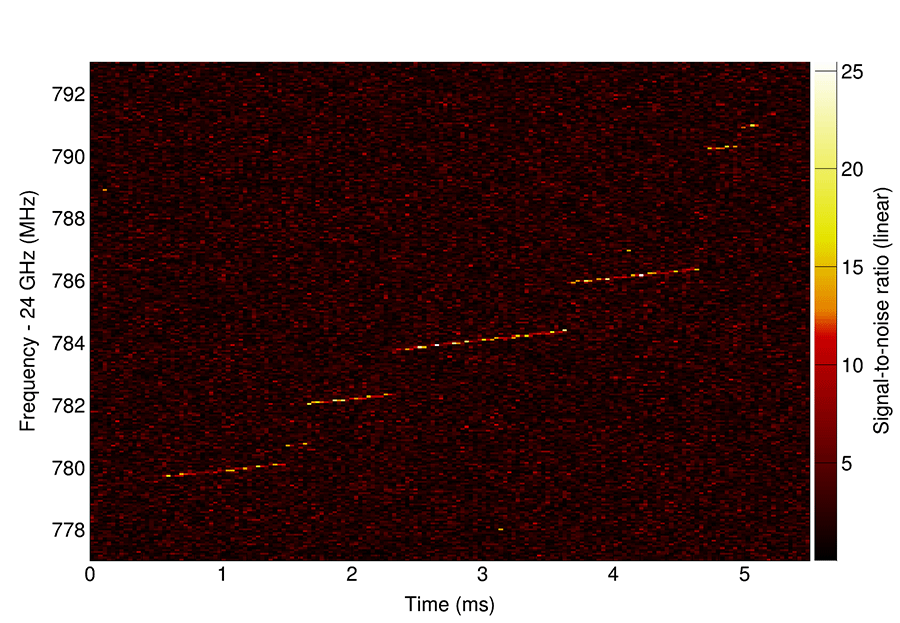Cyclotron Radiation from One Electron
Noli turbare circulos meos—do not disturb my circles—was the final wish of Archimedes, who demanded that Roman soldiers not destroy the perfect circular forms he had drawn on the ground. The literal opposite is true for a team of researchers who have designed a new way to accurately measure the tiny shifts in an electron’s circular orbit as the particle moves in a magnetic field. The experiment, known as Project 8, is run by a collaboration of 27 scientists from six institutions in the U.S. and Germany and it detects the frequency of radiation emitted by an individual, orbiting electron [1]. This frequency, and in turn, the electron’s energy, can be measured very accurately. If the energy resolution can be further improved, their experiment could lead to a new way to measure the neutrino mass.
Electric charges radiate when moving in circular orbits in a magnetic field, an effect that was first predicted by Oliver Heaviside in 1904. Cyclotron radiation has been observed in astrophysical radio sources and is the basis for generating x rays at synchrotrons. Radiation emitted by these sources comes from the motion of many electrons, but Project 8 is the first experiment to detect cyclotron radiation from a single electron.
The core of their apparatus (Fig. 1), which is located at the University of Washington in Seattle, is a small low-pressure gas cell (about the size of an espresso cup) inside a 1-tesla magnet. The cell contains a small amount of gaseous krypton-83, a radioactive isotope that produces electrons as its nuclei undergo beta decay. These electrons are forced into a circular orbit by the magnetic field and emit cyclotron radiation with a frequency of around 25 gigahertz (GHz), which is detected using sensitive microwave amplifiers.
The researchers plotted the detected radiation power as a function of time and frequency (Fig. 2). The bright, upward-angled streaks of radiation indicate the radiation emitted by a single electron. It is well known theoretically that a circling electron continuously emits radiation. As a result, it gradually loses energy and orbits at a rate that increases linearly in time. The detected radiation streaks have the same predicted linear dependence, which is what allowed the researchers to associate them with a single electron. (The jumps up in frequency shown in Fig. 2 correspond to the electron colliding with a residual atom or molecule in the gas cell.) By measuring the frequency associated with the first streak, the experimentalists were able to determine the energy of an electron emitted from a krypton-83 nucleus to within 30 electron volts (eV).
The Project 8 experiment was designed for a specific application: measuring the mass of the neutrino. Neutrinos, with electrons, are produced in beta decay. Their existence, first predicted by Wolfgang Pauli in 1930, is needed to ensure that beta decay conserves energy and angular momentum. The idea behind Project 8 is to measure the energies of the electrons emitted in beta decay and compare them to the total energy of the decay. If the neutrino has mass, no electron can have an energy equal to the total energy, since some of this energy must be used to make the neutrino. The mass of the neutrino can therefore be determined by measuring the maximum energy of the emitted electrons.
Physicists have always assumed neutrinos were very light. In the standard model of particle physics, they are considered massless, largely because the model was developed before any experiments indicated neutrinos had mass. This picture changed when experiments showed that neutrinos, which come in three flavors (electron, muon, and tau), morph from one type into another—a quantum phenomenon known as neutrino oscillation that only occurs if neutrinos have mass.
Neutrino oscillation experiments provide only a lower bound on the neutrino mass of about 0.01– 0.05eV/c2. For comparison, the next lightest elementary fermion, the electron, has a mass greater than 500,000eV/c2. This vast mass difference may just be an accident of nature. Or, it could indicate that neutrinos do not obtain their mass by the same Higgs mechanism that gives mass to all other fermions. Many competing theories exist that try to explain the origin of neutrino mass. Quite a few of these rely on the existence of particles that can only be produced at extremely high energies, well beyond the reach of the Large Hadron Collider or any conceivable particle collider. Ultimately, physicists will need to know the absolute value of the neutrino mass to sort through these theories. The neutrino masses are also important in cosmology and astrophysics. For example, their values affect the distribution and morphology of galaxies.
So far, neutrino oscillations are the only direct evidence for the magnitude of the neutrino masses. Attempts to determine the neutrino masses in the laboratory have only yielded upper bounds. The most stringent upper bound on the “flavor averaged” neutrino mass, mβ≤2.05eV/c2, comes from careful observations of the energy spectrum of electrons emitted in the beta decay of tritium [2,3]. The next generation of tritium decay experiment, the Karlsruhe Tritium Neutrino Experiment (KATRIN) [4], will measure electron energies with a large spectrometer, and is designed to measure a neutrino mass as small as 0.2eV/c2. With the technique KATRIN is using, however, the sensitivity to the neutrino mass can only be improved by building a larger spectrometer. And with KATRIN already the size of a building, a larger spectrometer is not realistic.
In comparison, Project 8’s energy resolution is not limited by size, but by the design of its magnetic field and the precision with which the researchers can measure the electron’s cyclotron frequency. Both aspects can, in principle, be improved. The Project 8 researchers intend to adapt their experiment to detect the simultaneous emission from many electrons produced in tritium beta decays [5]. Their current energy resolution of about 30eV is too low to measure the neutrino mass. For comparison, KATRIN has an energy resolution of around 1eV. But future versions of the Project 8 spectrometer could have an energy resolution that surpasses that of KATRIN. In principle, this technique might have a sensitivity sufficient to reach the range of masses indicated by neutrino oscillation experiments, and thus may guarantee the measurement of neutrino mass. The main challenge will be adapting the technique so it can accommodate many electrons at once yet still detect their individual cyclotron emissions.
This research is published in Physical Review Letters.
Correction (5 May 2015): An earlier version of this article incorrectly credited the drawing in Figure 1 to Ben Monreal. The drawing was by Luiz de Viveiros.
References
- D. M. Asner et al. (Project 8 Collaboration), “Single-Electron Detection and Spectroscopy via Relativistic Cyclotron Radiation,” Phys. Rev. Lett. 114, 162501 (2015)
- C. Kraus et al., “Final Results from Phase II of the Mainz Neutrino Mass Search in Tritium β Decay,” Eur. Phys. J. C40, 447 (2005)
- V. Aseev et al., ”Upper Limit on the Electron Antineutrino Mass from the Troitsk Experiment,” Phys. Rev. D 84, 112003 (2011)
- J. Angrik et al. (KATRIN Collaboration), KATRIN Design Report (2004); http://bibliothek.fzk.de/zb/abstracts/7090.htm
- B. Monreal and J. A. Formaggio, “Relativistic Cyclotron Radiation Detection of Tritium Decay Electrons as a New Technique for Measuring the Neutrino Mass,” Phys. Rev. D 80, 051301 (2009)







